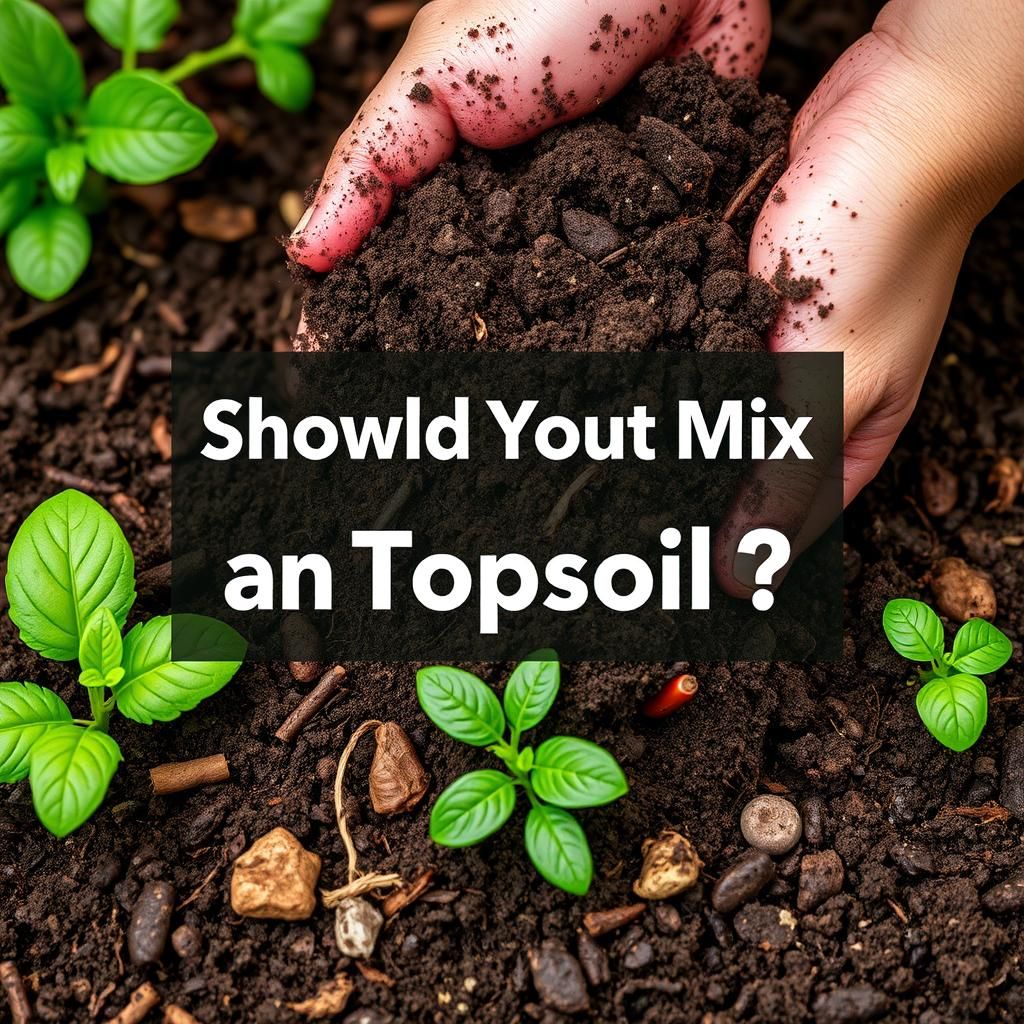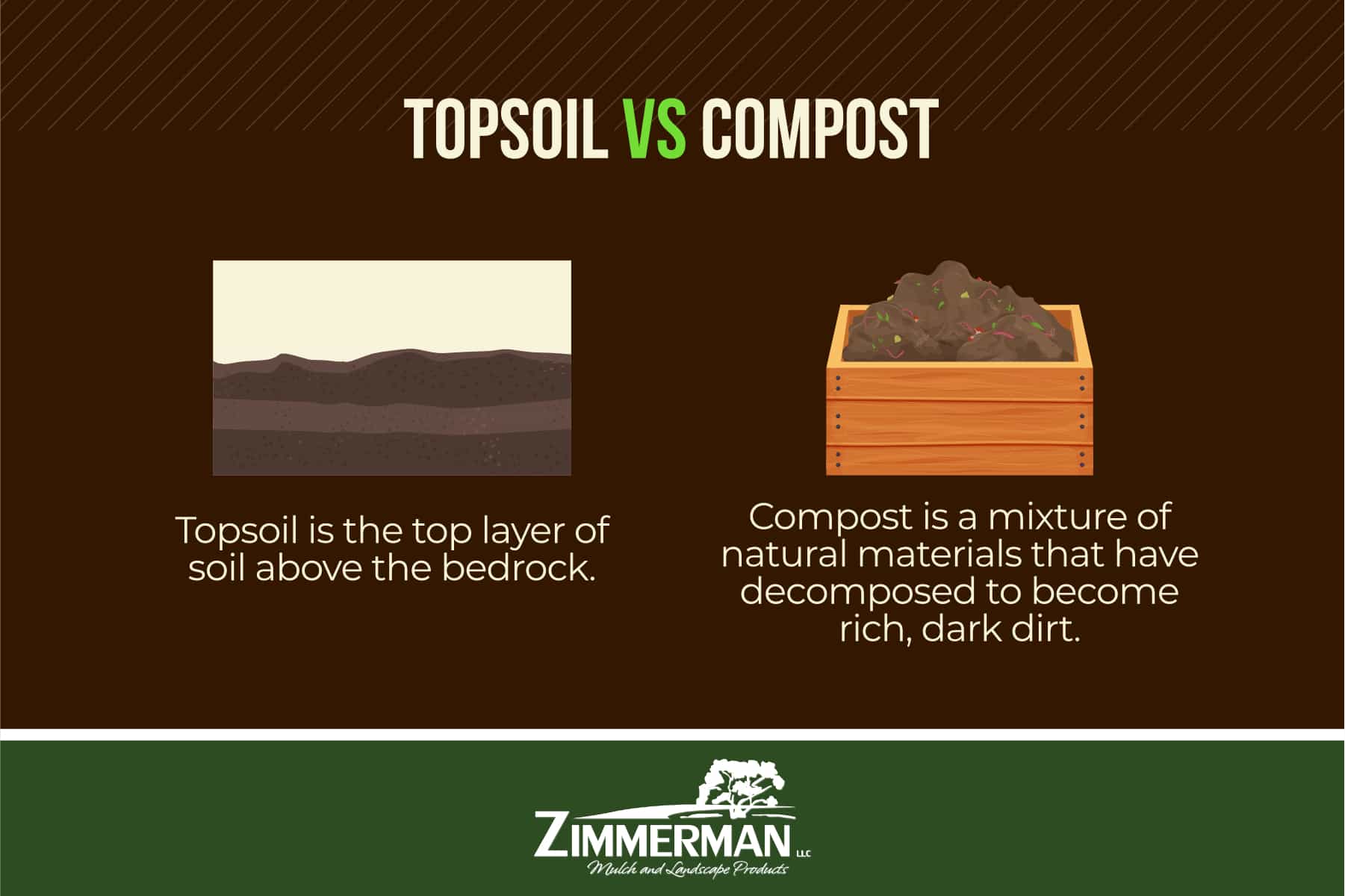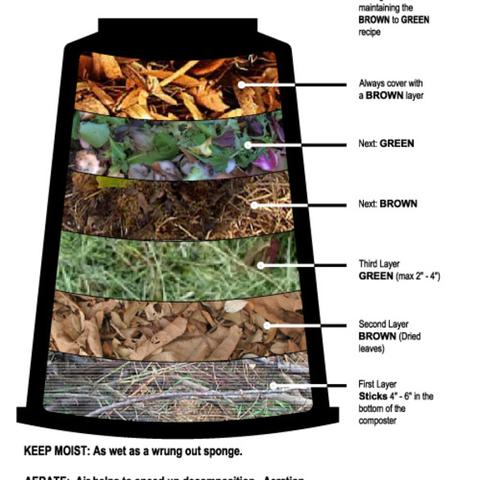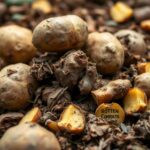Should You Mix Compost and Topsoil? Benefits and Best Practices for Your Garden

When it comes to gardening, understanding the right soil composition is crucial for optimal plant growth. One common question gardeners face is whether to mix compost with topsoil. Both elements offer essential nutrients and benefits, but their combination can significantly enhance soil health and plant vitality. In this article, we will explore the advantages of mixing compost and topsoil, discuss the best practices for this process, and provide insights to help you create a thriving garden. Whether you're a novice gardener or a seasoned horticulturist, understanding this blend can lead to a more fruitful and sustainable gardening experience.
Should You Mix Compost and Topsoil?
Mixing compost with topsoil can be beneficial for your garden, as it combines the nutrients and organic matter from compost with the structure and minerals present in topsoil. This mixture enhances soil fertility and promotes healthier plant growth by improving soil drainage, moisture retention, and aeration. However, it is essential to strike a balance, as too much compost can lead to nutrient imbalance or excess nitrogen, which might hinder plant growth rather than help it. Using a mixture in the right proportions can create an ideal growing environment for various plants, enriching the overall soil health.
Benefits of Mixing Compost with Topsoil
Mixing compost with topsoil offers numerous benefits, such as improved nutrient content, better moisture retention, and enhanced microbial activity. Compost provides essential nutrients that gradually release into the soil, while topsoil adds structure and stability. Together, they create a rich environment for plant roots to thrive. This combination helps to establish a balanced soil ecosystem, leading to higher yields and healthier plants, which are more resilient to pests and diseases.
How to Properly Mix Compost and Topsoil
To achieve the best results when mixing compost and topsoil, aim for a ratio of about 1:3 or 1:4, where one part is compost and three to four parts are topsoil. Begin by moistening the compost to ensure easier mixing, then combine the two in a wheelbarrow or on a tarp. Use a shovel or garden fork to thoroughly blend the materials until evenly distributed. This process will ensure that nutrients are uniformly available throughout the soil and that the beneficial microorganisms from the compost can effectively interact with the topsoil.
Potential Drawbacks of Mixing Compost and Topsoil
While mixing compost and topsoil has many advantages, there are potential drawbacks to consider. If the compost is not fully matured, it may rob the soil of nitrogen, leading to poor plant growth. Furthermore, over-amending with compost can cause an increase in salinity levels, which can harm plant roots. It is also crucial to ensure that the topsoil is free from weed seeds and pathogens, as they can be introduced into your garden when mixing the two materials.
When Not to Mix Compost and Topsoil
In some scenarios, it might be advisable to avoid mixing compost with topsoil. For instance, if the topsoil is rich in nutrients or has a specific pH level that suits your plants' needs, adding compost may disrupt this balance. Additionally, if you are working with plants that require specific soil conditions, such as succulents or certain acid-loving plants, it may be beneficial to keep the compost separate to maintain control over the soil environment.
Best Practices for Using Compost and Topsoil Together
To maximize the benefits of using compost and topsoil together, consider incorporating organic amendments like worm castings or perlite to enhance the mixture's effectiveness. Regularly test the soil for its nutrient content and adjust the compost-to-topsoil ratio as needed. It's also vital to incorporate organic matter on the surface of the soil periodically to maintain soil structure and fertility over time. Applying mulch can also help retain moisture and suppress weeds, complementing the compost and topsoil mix effectively.
| Aspect | Compost | Topsoil |
|---|---|---|
| Nutrient Content | High in organic material and nutrients | Variable, depending on source |
| Soil Structure | Improves structure and aeration | Provides stability and mineral content |
| Microbial Activity | High levels of beneficial microbes | Fewer microbes compared to compost |
| Moisture Retention | Retains moisture well | Varies based on composition |
| Usage | Enhances soil fertility | Base layer for planting |
Should compost be on top of soil?

Compost can be used in various ways in gardening and landscaping, and one common question is whether it should be placed on top of the soil. The answer is not straightforward as it depends on various factors such as the goal of the compost application, the type of plants, and the existing soil quality.
Benefits of Compost on Top of Soil
Applying compost on top of the soil can provide several benefits:
- Nutrient Boost: Compost acts as a natural fertilizer, gradually releasing nutrients as it breaks down.
- Moisture Retention: A layer of compost can help retain moisture in the soil, reducing the need for frequent watering.
- Weed Suppression: A thick layer of compost can inhibit weed growth, allowing plants to thrive without competition.
When to Apply Compost on Soil
There are specific situations where applying compost on top of the soil is advantageous:
- After Planting: For established plants, compost can be added on top to provide additional nutrients.
- Dormant Seasons: During late fall or early spring, a top layer can protect and nourish soil and plants.
- Before Mulching: Compost can serve as a base layer before adding mulch for improved soil structure.
How to Apply Compost Properly
To maximize the effectiveness of compost when applying it to the surface, follow these guidelines:
- Even Distribution: Spread compost evenly over the soil surface to prevent nutrient concentration in specific areas.
- Layer Thickness: A 1- to 3-inch layer of compost is typically sufficient; thicker layers may restrict water and air movement.
- Incorporation: For some plants, lightly mixing compost into the top inch of soil can enhance its effects.
Potential Drawbacks of Surface Compost
While there are many benefits, there are also some potential drawbacks to consider:
- Soil Microorganisms: Compost on the surface may attract pests if it doesn't break down properly.
- Runoff Risk: Heavy rains can wash away surface compost, leading to nutrient loss and soil erosion.
- Plant Competition: If not managed properly, compost can encourage weed growth, providing competition for plants.
Alternative Uses for Compost
Compost can also be utilized in other effective ways besides being spread on top of the soil:
- Soil Amendment: Mix compost into the soil before planting to improve overall soil structure and fertility.
- Liquid Fertilizer: Compost tea, created by steeping compost in water, can be used as a liquid fertilizer for plants.
- Potting Mix: Combine compost with other ingredients to create a nutrient-rich potting mix for container gardening.
Can you mix old soil with compost?

Yes, you can mix old soil with compost. This practice is often beneficial as it enhances the nutrient content of the soil, improves its structure, and promotes better water retention and aeration. When combining old soil with compost, it’s important to consider the condition of the old soil. If it's been previously used for planting, it may have reduced nutrient levels or potential disease issues. Therefore, mixing it with compost can rejuvenate the soil and provide necessary organic matter.
See also:
Benefits of Mixing Old Soil with Compost
Mixing old soil with compost offers multiple advantages that can help enhance the health of your plants and garden.
- Nutrient Enrichment: Compost adds essential nutrients that may have been depleted in the old soil.
- Improved Soil Structure: The combination of compost can help break up compacted soil, allowing for better root penetration.
- Water Retention: Compost enhances the soil's ability to hold moisture, reducing the need for frequent watering.
- Increased Microbial Activity: Compost introduces beneficial microorganisms that can help with nutrient uptake for plants.
- Enhanced Drainage: The addition of compost can improve drainage in heavy or clayey soils, preventing root rot.
Considerations Before Mixing
Before you proceed with mixing old soil and compost, there are certain factors to keep in mind to ensure successful results.
- Soil Condition: Inspect the old soil for any signs of disease or pests that could affect your plants.
- Balance Ratio: Maintaining the right ratio of old soil to compost (typically 2:1) is crucial for optimal results.
- Type of Compost: Use well-aged compost to avoid introducing pathogens or weed seeds into your soil.
- Moisture Levels: Make sure both the old soil and compost are sufficiently moist but not overly wet before mixing.
- pH Levels: Test the pH of your old soil; compost can help buffer but may also affect acidity or alkalinity.
How to Mix Old Soil with Compost
Mixing old soil with compost can be a straightforward process if you follow these steps carefully.
- Gather Materials: Collect your old soil, compost, and any necessary tools like a shovel or tiller.
- Break Up Soil: Use a shovel to break up large clumps of old soil, ensuring that it is loose and crumbly.
- Combine Ingredients: In a wheelbarrow or on a tarp, mix the soil and compost together thoroughly until well combined.
- Till into Garden Beds: Spread the mixture evenly over your garden beds and till it into the existing soil.
- Water: Water the area after mixing to help the components integrate and provide moisture.
Common Issues When Mixing
There are several common issues that gardeners may encounter when mixing old soil with compost. Being aware of these can help prevent problems.
- Imbalanced Nutrients: Too much compost can lead to excessive nitrogen, potentially harming plants.
- Anaerobic Conditions: Mixing too much wet compost can create anaerobic conditions, leading to bad odors and harmful gases.
- Inconsistent Texture: Not mixing thoroughly can result in uneven patches which may affect plant growth.
- Weed Seeds: If the compost is not properly sourced, it may introduce weed seeds into the garden.
- Pest Ensure that old soil does not contain pest larvae that could thrive in the new mix.
When Not to Mix Old Soil with Compost
While mixing old soil with compost is generally beneficial, there are specific scenarios where it might not be advisable.
- Contaminated Soil: If the old soil has been contaminated with chemicals or pathogens, mixing it with compost could spread the problem.
- Soil Compaction: In cases where the soil is extremely compacted, other methods like aeration may be more beneficial.
- Wrong Planting Conditions: For certain plants that require specific soil conditions, adding compost may alter the environment unfavorably.
- Excessive Salinity: If the old soil is saline, mixing with compost may not resolve the issue and could harm plants.
- Temporary Uses: For short-term planting, like annuals, you might not need to mix compost with old soil.
How to layer compost and topsoil?

To properly layer compost and topsoil, you should follow a systematic approach that ensures the nutrients in the compost are effectively integrated into the topsoil for optimal plant growth. Here's how you can do it:
1. Choose the Right Location: Select an area for layering that receives adequate sunlight and has good drainage. It's essential for the compost and topsoil layers to interact with soil organisms and environmental elements.
2. Prepare the Base: Start by removing any existing vegetation or debris from the area. This ensures that unwanted plants don’t compete with the new layers.
3. Add the Compost Layer: Spread a layer of well-decomposed compost over the designated area. The typical thickness for this layer should be around 2-4 inches. Ensure that the compost is rich in organic matter and free from any contaminants.
4. Incorporate Topsoil: Next, cover the compost layer with 2-4 inches of high-quality topsoil. It is advisable to use loamy topsoil that facilitates drainage and moisture retention.
5. Moisture Management: Water the layered area lightly to settle the soil and initiate the breakdown of organic materials.
6. Mulch Application (Optional): Consider adding a layer of mulch on top of the topsoil to retain moisture, suppress weeds, and provide organic matter as it breaks down over time.
Understanding Compost
Compost is decomposed organic matter that enriches the soil and helps retain moisture. It's essential to ensure that the compost is well-aged and contains a balanced mix of green (nitrogen-rich) and brown (carbon-rich) materials.
- Green Materials: Include kitchen scraps, grass clippings, and fresh leaves.
- Brown Materials: Incorporate dried leaves, straw, and cardboard.
- Aging: Aim for compost that has been decomposing for at least 3-6 months.
The Role of Topsoil
Topsoil is the uppermost layer of soil and contains the highest concentration of nutrients and organic matter. It is vital for plant growth as it supports root development and influences water retention.
- Nutrient Content: Look for topsoil that is rich in essential nutrients like nitrogen, phosphorus, and potassium.
- Texture: Choose topsoil that has a loamy texture, which balances sand, silt, and clay.
- pH Levels: Ideally, the pH should be neutral (around 6-7) to optimize plant growth.
Layering Techniques
Proper layering involves distributing the compost and topsoil evenly. A stratified approach can help enhance the nutrient flow between the layers.
See also:
- Base Layer: Create a level base to support the compost layer.
- Layer Thickness: Maintain consistent thickness for each layer to ensure even distribution of nutrients.
- Mixing: Consider lightly mixing the top few inches of each layer to promote the integration of nutrients.
Maintaining Moisture
Moisture management is crucial for the breakdown of organic materials and for maintaining healthy plants.
- Watering: Water the layers lightly after setting them up to encourage soil settling.
- Drainage: Ensure the area has proper drainage to avoid waterlogging.
- Observation: Regularly check the moisture level and adjust as necessary, especially during dry spells.
Benefits of Layering
Layering compost and topsoil provides several benefits for plant growth and soil health.
- Nutrient Enrichment: Compost adds critical nutrients to the soil structure.
- Soil Aeration: Improved air circulation and drainage lead to healthier root systems.
- Microbial Activity: Encourages beneficial microbes that assist in nutrient breakdown.
Do you add compost or soil first?

When deciding whether to add compost or soil first, it is essential to understand the specific gardening or landscaping context in which you are working. Generally, the recommended approach is to combine both, but the order depends on the situation. If you are starting with bare ground, it usually makes more sense to begin with soil, especially if you are looking to build up the garden bed or improve drainage. However, if you are working with existing soil and want to enhance its quality, you can add compost first.
Understanding Soil Types
Different types of soil require different treatments for optimal plant growth. The primary soil types include:
- Sandy Soil: Drains quickly and may need more organic matter.
- Clay Soil: Heavy and holds water; adding compost can improve its structure.
- Silty Soil: Retains moisture well, but still benefits from additional nutrients.
When assessing whether to add compost or soil first, consider the type of soil you are dealing with, as this will affect how well your plants grow.
The Role of Compost
Compost serves as an excellent source of nutrients and can enhance soil structure. It offers various benefits:
- Nutrient Supply: Compost adds essential nutrients that encourage healthy plant growth.
- Soil Structure Improvement: It enhances drainage and aeration, particularly in clay soils.
- Microbial Activity Stimulation: Compost encourages beneficial microorganisms that help in nutrient uptake.
Adding compost can significantly improve your garden's overall health, but the timing of its application is crucial for maximizing these benefits.
When to Add Soil
In many cases, especially when preparing a new garden bed, adding soil first might be the best choice. The reasons include:
- Leveling Ground: A solid base of soil allows for leveling and creating a stable planting area.
- Drainage Control: New topsoil can help with drainage and prevent water logging.
- Foundation for Layers: A base layer of soil provides a good foundation for subsequent layers, including compost.
Establishing a quality soil foundation is crucial for any gardening project.
Combining Soil and Compost
In many gardening practices, a combination of both soil and compost is ideal. Here’s why:
- Balanced Nutrient Levels: Mixing soil with compost creates a nutrient-rich environment that is conducive to plant growth.
- Enhanced Texture: The combination improves aeration and drainage, essential for root health.
- Improved Fertility Over Time: Organic matter from compost continues to break down, enriching the soil gradually.
This method ensures that you capitalize on the benefits of both materials effectively.
Best Practices for Application
When applying compost or soil, following best practices can greatly improve your gardening success:
- Layering Technique: If adding both, start with soil, then layer compost on top.
- Mixing Thoroughly: Ensure that compost is well-mixed with soil for even distribution of nutrients.
- Testing Soil: Prior to application, testing your soil can reveal pH and nutrient levels, guiding your choices.
By adhering to these best practices, you can create a thriving environment for your plants.
Questions from Our Readers
Should you mix compost and topsoil?
Yes, you can mix compost and topsoil. Combining these two materials can enhance your garden's soil quality by improving nutrient content and drainage.
What are the benefits of mixing compost with topsoil?
Mixing compost with topsoil provides a rich nutrient source for plants, encourages healthy soil structure, and improves water retention, leading to better overall plant growth.
See also:
How much compost should be mixed with topsoil?
A common recommendation is to mix about 20-30% compost with 70-80% topsoil. This ratio allows for significant nutrient enhancement without overwhelming the soil.
Can you use finished compost directly without mixing it with topsoil?
Yes, you can use finished compost directly in your garden, particularly as a top dressing or mulch, but mixing it with topsoil is often beneficial for seed planting and improving overall soil health.

If you want to read more articles like Should You Mix Compost and Topsoil? Benefits and Best Practices for Your Garden, we recommend you check out our Compost category.
Leave a Reply
Related Articles